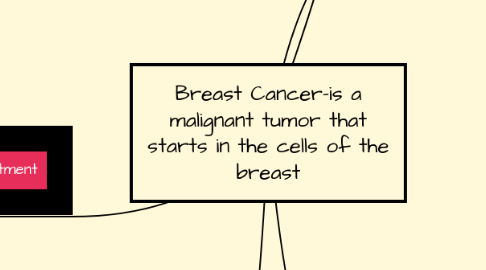Breast Cancer-is a malignant tumor that starts in the cells of the breast
by VeoLega 10

1. relationship if immunity to breast cancer
1.1. chemotherapy weaken the immune system
1.1.1. Chemotherapy target rapidly dividing cells
1.1.2. Chemotherapy damage the bone marrow
1.1.3. the bone marrow is less able to produce enough red blood cells, white blood cells, and platelets typically the effect is on white blood cells
1.1.4. when you don't have enough white blood cells you are more vulnerable to infection because nothing will fight the virus or bacteria.
2. Treatment
2.1. Radiation Therapy- adjuvant radiation therapy- is applied post mastectomy to prevent recurrence
2.2. Surgery--mastectomy, breast conserving surgery, axillary lymph node disection, adjuvant therapy
2.3. Endocrine therapy-antiestrogen, aromatase inhibitor, ovarian ablation, ovarian supression
2.4. Chemotherapy- can be given pre surgery to shrink the tumor or post surgery to prevent relapse
3. Diagnosis
3.1. breast screening
3.2. Mammogram
3.3. ultrasound
3.4. biopsy or fine needle aspiration
3.5. Pathological diagnosis determines if malignant or benign
3.6. Staging is done using TNM system but molecular markers correlate better with prognosis
4. Clinical features
4.1. breast mass
4.2. nipple discharge
4.3. mastalgia
4.4. SOB if metastatic to lungs
4.5. bone pain and hypercalcemia if metastatic to bones
4.6. abdominal distention and jaundice if metastatic to liver and peritoneum
4.7. altered cognitive level if metastatic to brain
5. Risk factors
5.1. Gender-females
5.2. Age-risk increases with advancing age
5.3. Height and Weight- taller women has slight increased risk likely correlated with hormonal stimulation.. Higher BMI is a risk for postmenopausal women.
5.4. History of Benign Proliferated breast disease
5.5. History of cancer
5.6. Reproductive history- early age <12 and late age > 55--proliferation of breast epithelium occurs in the luteal phase of the ovulatory cycle increasing risk of promotion of initiated cells
5.7. Exposure history-hormone replacement therapy, (estrogen and progesterone promotes preneoplastic lesion; ionizing radiation; smoking and alcohol
5.8. Family history--affected first degree relative,hereditary breast and ovarian cancer, Li-fraumeni syndrome, cowden syndrome
5.9. BRCA 1 and BRCA 2 mutations



